Something has to give.
Starting to be a fascinating phenomenon: Rates charged by trucking companies and other transportation providers continue to surge on a year-over-year basis even as the volume of shipments has dropped below where it had been a year ago, while the “capacity squeeze” of 2018 has disappeared, and as the price of fuel is down year-over-year.
Freight shipment volume across all modes of transportation – truck, rail, air, and barge – in January ticked down (-0.3%) from January last year, according to the Cass Freight Index, the second year-over-year decline in a row. Those two declines are the first since the transportation recession of 2015 and 2016. The extraordinary plunge since the extraordinary peak in shipments last summer indicates that the transportation boom with its double-digit year-over-year increases has fizzled. This chart shows how freight volume changed from the same month a year earlier:
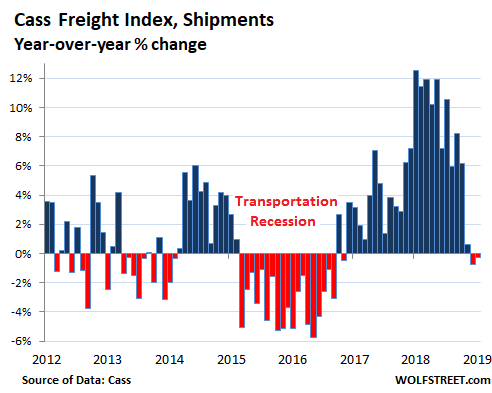
The Cass Freight Index covers shipments of merchandise for the consumer and industrial economy via all modes of transportation, but it does not include bulk commodities, such as grains or chemicals.
The year-over-year comparison in the chart above – for example, comparing January 2019 to January 2018 – eliminates the noise caused by the hefty seasonal fluctuations of the transportation business that occur every year.
But the chart also delineates the notorious cyclicality of the transportation business, where some big up-years are followed by down-years, such as the drop in shipments during the “transportation recession” of 2015 and 2016, when the goods-based sector of the economy itself went into a recession, and only the strength of the service economy kept GDP growth positive (at a miserably low 1.6% in 2016). The transportation recession was followed by a historic surge in shipments from late 2017 through the first half of 2018, causing a capacity squeeze that triggered a lot of hand-wringing among shippers, such as retailers and industrial companies. That boom and capacity squeeze have now been unwound.
This capacity squeeze in the trucking industry, and the subsequent resolution of it, shows up in the DAT Load-to-Truck ratio which tracks the demand-capacity balance. This ratio for “vans” – the trailers that Class-8 trucks haul across the US – surged twice in 2018: First, the spike in January 2018, when use of Electronic Logging Devices (ELDs) became the law, which caused a temporary squeeze as truckers had to rejigger their operations; and then, the flood of demand in the summer blew the ratio out again. But the demand-capacity balance is now reverting to the mean:
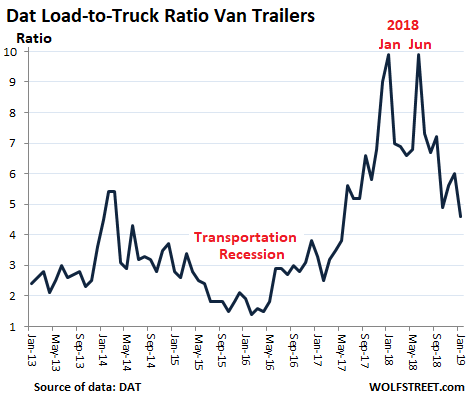
A good portion of the equipment and supplies for the industrial sector – manufacturing, oil & gas drilling, construction, mining, etc. – is transported by flatbed trailers. Demand for flatbed trailers skyrocketed in early 2018 as capacity suddenly tightened under the pressure that ELDs put on the industry, while demand was strong. DAT’s Load-to-Truck ratio experienced a historic spike from January through April 2018, then reverted to the mean and overshot the mean on the way down:
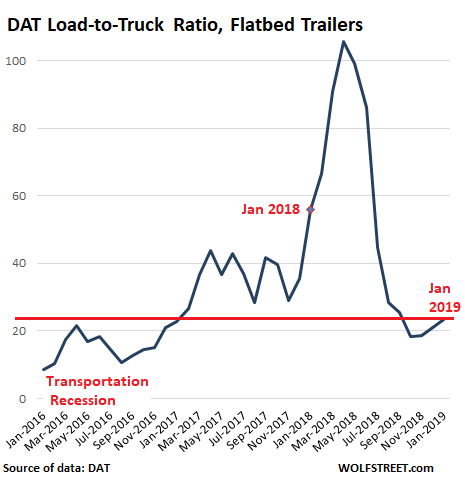
Rising capacity and declining shipments, no problem: Freight rates continue to surge. In January, the Cass Truckload Linehaul Index, which tracks per-mile full-truckload pricing and does not include fuel or fuel surcharges, rose 6.4% compared to January 2018. But that year-over-year increase in truckload pricing is backing off from the double-digit spikes last summer:
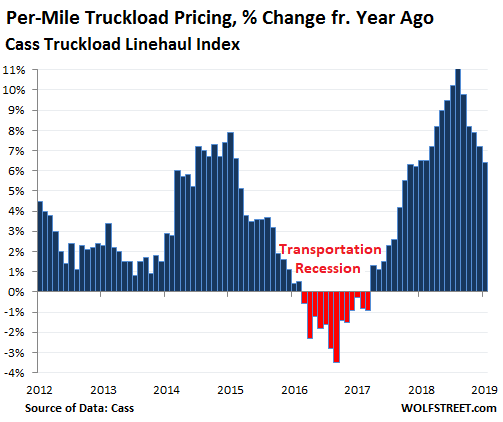
The average diesel price at the pump in January was slightly down from a year earlier, according to EIA data.
Yet the Cass Intermodal Price Index, which includes diesel prices and fuel surcharges, still rose 6.8% in January, compared to a year ago — but a far cry from the six double-digit year-over-year increases in a row last year.
Intermodal freight in the US is a combination of truck and rail, such as containers hauled by truck and then transferred to rail, or semi-truck trailers that piggyback on special rail cars. The chart below shows the blistering price increases in 2018 and continuing through January 2019, even as fuel prices are faltering:
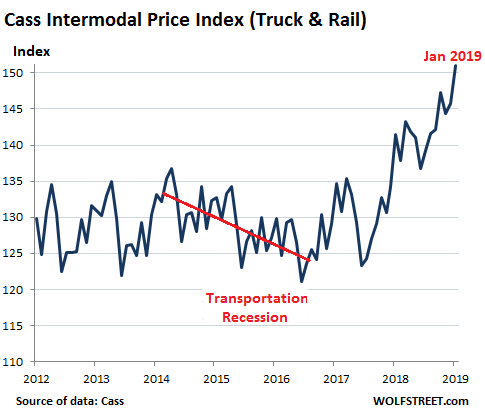
In terms of overall expenditures for freight: For all modes of transportation combined – truck, rail, air, and barge – shippers spent 7.8% more in January to get their goods delivered than they’d spent a year ago, despite the decline in shipments, according to the Cass Freight Index for Expenditures. This increase in freight spending was caused by the continued though somewhat slower price inflation in transportation services.
In the stacked chart below, where each line represents one year, January 2019 is way above all prior Januaries. Note the seasonality: January usually marks the low point of the year! The year 2018 (black line, on top) was an outlier in the bunch. And January 2019 is an even further outlier:
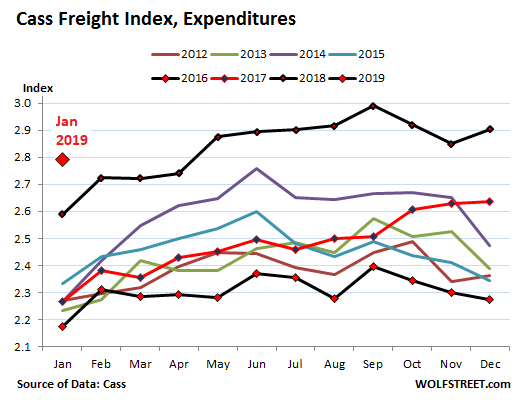
The above chart shows what inflation in “transportation services” looks like: even as shipments decline, shippers such as retailers and industrial companies, are having to pay a lot more to get their goods to the destination. But this too has started to back off just a tad from the red-hot pricing environment last year.
Ultimately, something has to give: in an environment of weaker shipments and more capacity, freight rates cannot continue to surge.
And given the rising capacity, and the declining shipments, trucking companies have backed off their historic binge of ordering Class-8 trucks. In January, orders for these trucks plunged by 58% from a year ago, to the lowest level since October 2016, toward the end of the “transportation recession” when Class-8 truck orders had plunged to the lowest levels since 2009, and truck and engine manufacturers responded with layoffs. So that U-turn was fast, even for the legendarily cyclical trucking business. Read… Phenomenal Trucking Boom Ends, Trucking Bust Starts
Enjoy reading WOLF STREET and want to support it? You can donate. I appreciate it immensely. Click on the mug to find out how:
![]()


Another measure of global economic health;
The Baltic Dry Index (BDI) Bulk dry oceanic shipping.
After hitting a high of 1,800 just 6 months ago, it is now at 639 points!
Some tend to dismiss this index for various reasons, however it still holds validation in that it clearly shows the state of global bulk shipping demand.
Taken in conjunction with other economic (micro/macro) fundamentals, the overall picture that emerges is not good.
Thank you Wolf.
“something has to give” all aboard the ‘Crazy Train’!
Any decline in Baltic Dry Index is more than counterbalanced by Grubhub delivering Taco Bell to your home. There is also DoorDash app, Instacart, etc etc
“Grubhub delivering Taco Bell to your home…”
For those of us who also wish to experience diarrhea without leaving the comfort of home….
No, the index shows demand/supply. Supply has grown a lot as MC01 explained, so the index has stalled. It s overcapacity, through “leverage” (and technology), as often happens in this easy monetary age.
The bulk carriers only comprise 11% of the total global fleet.
The BDI still remains as an indicator of world trade, which is the weakest since March of 2010 and continues to deteriorate.
Front-loading of imports has helped buoy container shipments, ahead of US – China trade disputes and has now drastically slowed amid tighter credit market conditions
Global export orders, international air freight, automobile production and sales, electronic components, agricultural raw materials, etc. Are all down.
To dismiss the BDI as an “oversupply problem” is to miss out on the overall global trade slow down, of which bulk shipments are a vital component.
I did see an article somewhere that UPS and some other shippers are putting limits on how much of Amazon’s packages they take because Amazon ships such a huge number of “low value” (the article’s words not mine) packages. You can see how shipping large numbers of “low value” packages to large numbers of locations would be cost intensive because of all the handling. Add this to the increases in fuel cost, driver cost(due to reduced driver productivity), and rig cost and it isn’t hard to see where the shipping cost increases come from. I wonder, as with Uber, if the whole business plan is coming up against the limitations of its success.
There was also an article about the so called “Environmentally-Friendly” Shipping wrapping/bags Amazon uses…it keeps clogging up the Recycling machines,which need to be stopped and cleaned…lolol only in America
A less-than-truckload (LTL) carrier, New England Motor Freight, went bankrupt last week among other reasons because of a huge Amazon contract (“low value”) that had made it hard for the company to obtain and handle higher value business.
In addition I am sure Amazon’s payment time-frame did little to help provide them timely Cash-flows…!
They had a truly interesting business model too. As far as I am aware most, if not all, of their tractors were single axle (instead of two axles at the rear of the tractor there was only one) which saved money from purchase right through the life cycle (less tires and brakes to replace, less weight, etc). Also they absolutely hated to buy new equipment!
Their tractors and trailers would be ran into the ground before being disposed of. The shop guys at NEMF could put anyone else in the industry to shame cannibalizing those old trucks and trailers to keep others up and running.
Their drivers were paid ok with decent benefits from my understanding but not near the top of the game (and they had great drivers too…I remember one who could alley back from a busy street basically blindfolded).
I guess Amazon and taxes (remember NEW ENGLAND Motor Freight) finally got them. Property taxes and “fees” on all those terminals, and all that cheap freight had to be the final nails in the coffin.
I’ve driven trucks since 1996 and seen this happen time and again but this one surprised me. Frugal, I guess, can only take you so far sometimes.
Based on the tremendous value I see in LTL (can ship 3000# pallet couple states away in a day or two, B to B with fork/dock, for couple hundred) it must be extremely competitive.
Sometimes a customer says ‘Hey I’ll give you this order, but it is absolutely, positively, life-or-death important that it deliver tomorrow’. I say ‘Fine, you just need to pay an extra $100 for guaranteed delivery. If it’s late, you get your total freight cost back, but still owe for the materials.’ If they say ‘Whoa I can’t pay an extra $100’ then I say (to myself), ‘Well, I guess it isn’t all that important, is it?’
My guess is Amazon is a huge pain in the butt and not willing to pay for the privilege.
I’ve seen a number of firms with limited assets or poor asset management practices, chase after a “big contract”. Only to be crushed by the inability to service their profitable small business clients while servicing the big deal that doesn’t pay well or demands services well beyond standard. Something like not putting all your eggs in one basket. Sorry for the run on sentence. GB
Like everything else with the Elite that don’t pay taxes, imagine if (only) the largest truck owners would be taxed properly. Leave the little guys out of it.
We’ve got a huge problem with the I-5 Bridge going from Seattle/Vancouver across the Columbia River into Portland, Oregon and beyond.
Huge traffic jams when these bohemoth trucks take over the road, which is everyday except Sundays.
People are screaming about this snarled mess especially those who commute from Vancouver into Portland.
But no politician EVER raises the most glaring example of interstate/intrastate trucks, owned by the Elite, and demand these long hauls start paying taxes enabling the states to build proper bridges.
Oregon and Washington had great opportunities to build a new bridge 40, 30, 20, and 10 year’s ago. A bunch of NIMBY’s and no-light rail advocates got in the way. Otherwise funded.
Most of those trucks are owned by poor immigrant owner-operators. Major fleets are a tiny percentage of overall trucking capacity.
“(Amazon’s) whole business plan (may be) coming up against the limitations of its success.”
There’s no indication of that yet, locally. One sees the UPS trucks everywhere on our roads, throughout each day.
I ordered one item in 1997 (a book – that’s all that Bezos sold, back then).
I ordered 188 items in 2017, most small and most Amazon Prime (two-day delivery guaranteed).
I have placed a total of 1,033 0rders since 1997.
UPS has been and continues to be exemplary with their on-time deliveries.
A couple of my UPS shipments have been delayed, most recently due to the freeze in the Midwest. Understandable, but a little nerve-wracking if it’s something important and/or expensive when it’s in limbo for a week or more (‘Delivery Schedule Unavailable at This Time’).
I ordered a conversion nut to attach my American faucet to a European water pipe. $9 set cost $35 to ship express from new Jersey, across the atlantic….. All the way to egypt. Amazon even refunded me $2 a week later due to miscalculating the import duty. Anyway, my faucet works now. Globalization for the win.
Amazon’s business plan (profitability) is not retail sales. It’s web services.
They may have made a few bucks off your orders. I guarantee Amazon has lost money on me. I shop sales, etc. They lose money on those.
It’s a shipping model called “low density” (meaning the shipment of voluminous but lightweight goods) which has been piooneered by the healthcare industry for shipping drug components from where they are synthetized (usually Asia) to where they are “packaged”, meaning mixed with filler, put in blisters etc. Think climate controlled containers carrying inside a tonne or often less of drug components.
Volga-Dnepr has made a bundle from it by embracing the model sooner than everybody else through their AirBridge Cargo subsidiary which has come to dominate the (legal) drug trade.
Low density is the backbone of ecommerce and DHL has been working side to side with Amazon in Europe for years to develop it, to the point a part of their air cargo fleet (mostly Boeing 757) has been optimized for low density operations. Amazon is quietly exporting that business model to the US: Amazon Air was set up following this experience and DHL is also providing the expertise for Amazon to set up their own road-transport service. Amazon owns a (rapidly expanding) fleet of trailers in several US States and has its own in-house brokerage firm to provide the tractors.
UPS is becoming a bit of a dinosaur as far as shipping companies go and they need to make a choice: either work with Amazon or find other customers. Truth to be told they need to make a lot of choices right now but that’s another matter.
Tough to compete with a company that can make 11 billion and pay no tax.
What did you expect? The industry bought a bunch of new (more expensive) equipment, they are passing on their costs. What would be appropriate at the government level would be to rollback load capacity, (and save the highways since we probably can’t afford to fix them and this has been a brutal winter) which would put more trucks to work assuming also that cargo capacity is in long term decline, the slowdown is the new normal. Everything costs more and you get less.
Less is more and smaller is bigger
That shack there is worth six figures.
Up is down and profit a loss
This is where you sign to pay the cost.
High is low and rich is poor
Is what you’ll find as you walk out the door.
Burma Shave
Within this vale of toil and sin
Your head grows bald but not your chin.
Wolfs follow up on the bankrupt LTL gives this more meaning. With low margin carriers dropping out prices will go up and service will go down.
Alas Amigos…..thanks to Wolf,,,these subtle Economic warnings,just keep rearing their ugly heads on a continuing basis. The economic ‘train wreak’ is slowly coming into View…! Another 45 days or so,even Wolf will be a believer…lololol aloha
Larry Kudlow says it’s just a ‘glitch.’ We’re really in trouble now.
Cost are definitely rising, drivers wages still have a way to go to catch up, insurance seems to be up thanks to law suits for every minor accident that happens, lawsuits from drivers to companies over missed lunch breaks here in Calif, new equipment cost are much higher to maintain engines and emissions. We are forced to update our equipment now to comply with smog laws, engines are much more expensive to rebuild compared to years past. Real estate here in So Calif for a trucking terminal is extremely high to the point you wonder if its worth remaining in business here or pull the plug and release the property.
Is this product of the inherently cyclical nature of the transportation economy and by extension the greater economy.
Or a symptom of a greater rumbling caused by credit beginning to siezing up?
Its a trucking mess (so to speak ).
Bill…think most people missed your innuendo….lolol
A genuine pun! (not just “pun” used as generic for a joke)
Oct 14, 2011 Ron Paul – Don’t Blame Capitalism.
This is Corporatism, A Special Interest System
https://youtu.be/hH4T02U5TTY
The 1976 film “Network” described it nearly perfectly 43 years ago:
https://www.youtube.com/watch?v=V9XeyBd_IuA
Yes.
True then, truer now.
What exactly is being shipped to keep volumes almost as high as 2018?
Retail in the toilet, autos in the toilet, construction slowing.
What’s left?
Toilet paper. Literally.
This, the last graph, could explain the serious jumps in food costs here and not just at the supermarket. Chain and solo restaurants both jumped together at the first of the year. Fixed income (VA disability) and it’s out pacing the CPI by far, even compared retrospectively. Fresno, CA (as if that matters).
With all the negative economic data, what continues to drive stock market prices higher? On another matter, the stock market they say is suppose to be well informed and factor in all the positive and negative news and near term expectations. Could it be that the U.S. stock market is rising because investors see no where else to put their money? Seems like a big gamble. By historical measures the stock market is high and given slowing economic indicators, seems rife for a decline soon. Thoughts?
What scares me is the inverted yeild curve chart pattern. https://www.gurufocus.com/yield_curve.php Almost like an investors almanac..
Guru focus – great site!
Thanks Bobby
There is still a lot of money out there, and folks aren’t happy with CD’s at 2%, lots of the high dividend stocks are doing just fine, and almost all have recovered the xmas drop.
I would speculate that the ‘traders’ got taken to the woodshed, and the buy&hold ‘value’ folks are doing just fine.
Yes, the investors have no where else to put there money, but like the guy said in 1932 “This too shall pass”.
Me thinks this is not the end of the world, just reality fighting with virtual-reality, I think this site ‘wolf’ represents reality, something that is hard to find in modern ameriKKKa.
Lastly, its clear that USA will keep fabricating USD until they can’t, which means it will flow to stock-market, until DEM’s pass some kind of tax on holding stock (Wealth Tax). Hopefully this will not happen, but we live in crazy times, where most of the politicians are morons, but they’re still in IQ terms a tad above ‘average’ minion who vote for them.
You can’t fight the FED, and you can’t fight long-term value; There are lots of good company’s, and they continue to grow and improve.
The problem with the stock market is the ‘speculators’, but they always get shaved in the end, the real problem is to be an investor, and not a speculator. I think JP Morgan said it best long ago “It’s harder to keep your money, than it is to make it”. Investors try to ‘keep’ their money, speculators try to ‘get rich quick’, which is the majority, and they be fools and/or morons, e.g. losers.
Stock markets are forward looking…The “Crash” into the Xmas lows have already discounted this weakness .
You might as well ask, “With The Venezuela economy in the crapper, how does the Caracas Stock Exchange keep going up?”- because it is leagues ahead of all other exchanges, recently over 5,000, and that 5,000 is AFTER having had three zeros cut from it.
The answer, of course, is inflation, and there is no greater truism than that inflation keeps pace with the expansion of a nation’s debt. Each of the last ten years the U.S. national debt has risen the better part of a trillion dollars. Why should the stock market not relentlessly rise? (especially insofar as the Fed Chief just took a more dovish stance re balance sheet normalization)
Powell had totally flipped. The Fed has said if stocks decide it will deploy much larger QE much more readily for much longer periods of time before cutting rates to zero.
FDX, UPS, NSC and CSX continue to forecast revenue and earnings growth for 2019.
It seems that Xmas was a good buying opportunity.
This is really interesting observation by astute commenters could it really be that the online order business is faltering ,low value trinkets. beany babies and shit that we sell at our garage sales.what a joke the whole thing has been ,all of this everything bubble is eating itself up
XPO Logistics will issue $1bn worth of bonds to buy back shares after issuing two profit warnings. I want whatever these people are smoking.
Hey, people will scarf up the bonds. And at the company’s first bankruptcy the bond holders will trade in the bonds for shares. U.S. capitalism in action!
Capitalism has been reduced to a few hundred ants running around chasing the scraps left over from the elephant kings who control the economy. Sounds more like fascism to me; or maybe a rigged casino.
. . .
What do you call it when the gangsters (with money and guns) call the shots? No one in power gives two shits about the man on the street.
https://theintercept.com/2019/02/19/andrew-wheeler-renewable-fuel-standard/
Its competition for the scum on the bottom, sweet deals for the well connected at the top. aka: capitalism in the 21st century.
Hi Wolf
The low value shipments are what are killing malls and brick and mortar retail. No one will even go to the Target or Walmart to pick up a $5 bottle of shampoo. The only foot traffic is being generated by groceries and fresh meats and baked goods.
The future is for more low value shipments. What they shippers need to do is velcro boxes together going to similar route destinations to miinimize handling.
I for one will not go to Walmart to buy a $5 bottle of shampoo. My wife turned me on to Dollar Tree a few years ago. I was kind of reluctant at first, but now I’m a total fan. I go there and buy a $1 bottle of shampoo, conditioner, body wash, laundry detergent, softener, any kind of plastic storage container, etc, etc. I go to Walmart and think, look at the prices! And then to Winn-Dixie or Publix (I’m in Florida) and they make Walmart look expensive (and they really have gone up a lot!). Food prices have gone through the roof — at the big chains — but I buy the same quality of food from Aldi (their knockoff products are often better than what they are knocking off) and Save-a-lot. A lot of what you spend depends on where you shop. I’ll pay up for something if I think the quality is significantly better, but if not — I buy cheap.
Yep, this has to be passed on, I just recently shipped a container (FCL20) to Asia, started that process in August 2018, arrived XMAS in Asia, original Maersk quote was $1200 USD, the final actual Maersk was $2700 USD DUE (REAL is they HOLD until you pony up balance), how we might ask how price went up +2X?? Well they said they’re costs had gone up, but mostly the problem is their shipping has gone down, and they have passed the cost of fueling vessels onto the container shipper. Vessels sail on a regular schedule, so it clear loads have dropped dramatically.
So we might ask, at what point does these ‘costs’ getting passed on to the shipper, get passed on to the people in the form of inflation?
Lastly, how do they justify increases, well its mostly the loose definition of surcharges, that are ‘flexible’, but the interesting thing is in the last few years the final price was fairly close to the ‘quote’, now things are just plain crazy.
That is the dilemma for businesses. Costs keep going up but if they raise prices their products don’t sell. What are the options? Many are just hanging on month after month, year after year operating at a slight loss or barely coming out even. Holding out for a chance that in the future they will be the only company left standing and will be able to corner the market.
PCAR is just a few % from the 52wk high.
Although, it might seem that freight shipment cost more, unfortunately this money does not get passed down to owner operators and small trucking companies that actually do the work. With brokers being between shippers and truck owners they control what truckers are paid. I have been in business over 12 years now and there is no solution to this problem, there always will be truckers that accept freight below the operating cost. Another problem is mega trucking companies with contracts with fortune 500 companies they are paid $4-$5 a mile and it does not matter to them what they get on backhaul loads.
– The ratio between the transportation index and the Dow Jones (think: Dow Theory) has continued to deteriorate since say early september 2018.
There’s a pattern going on, raising prices when business or business conditions falter. The most egregious stupidity I’ve seen is Samsung making exactly the same mistake and rolling out more expensive phones than ever only a short time after Apple did it with disastrous results. Probably there was an unstoppable Sclieffen plan in place. They snorted some hopium and did it anyway, addicted to success as they are. The world must rcognize their greatness and buy.
BTW the last export numbers from S, Korea to China were so horrible that they were stunned at the Bloomberg Asia desk. That freight train isn’t slowing down, the one of the economy falling apart. Au contraire…